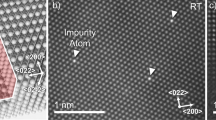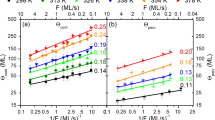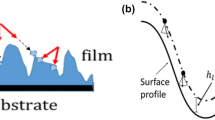Abstract
HERE we describe briefly the results of some recent experiments on the diffusion of tungsten atoms over an atomically clean surface of tungsten. The method used was that of following the decay with time of a series of sinusoidal grooves in the surface of the specimen at various temperatures. Mullins1 has shown that the depth of the grooves at a time t is given by  where ω = (2φ/the wavelength of the groove). The terms in the exponent are the contributions to the smoothing process due to evaporation, volume diffusion and surface diffusion respectively. A, B and C are functions of temperature, so that by careful choice of temperature and wavelength it is possible to make surface diffusion the dominant mechanism of mass transfer, corrections being made for the other two processes. B is given by
where ω = (2φ/the wavelength of the groove). The terms in the exponent are the contributions to the smoothing process due to evaporation, volume diffusion and surface diffusion respectively. A, B and C are functions of temperature, so that by careful choice of temperature and wavelength it is possible to make surface diffusion the dominant mechanism of mass transfer, corrections being made for the other two processes. B is given by  Ds = D0 exp (−QS/RT), where Qs is the activation energy for surface diffusion, vs is the specific surface free energy, Ω the atomic volume and N the number of atoms per unit surface area. Thus from the decay constant in equation (1) it is possible to obtain the surface self-diffusion coefficient, Ds.
Ds = D0 exp (−QS/RT), where Qs is the activation energy for surface diffusion, vs is the specific surface free energy, Ω the atomic volume and N the number of atoms per unit surface area. Thus from the decay constant in equation (1) it is possible to obtain the surface self-diffusion coefficient, Ds.
This is a preview of subscription content, access via your institution
Access options
Subscribe to this journal
Receive 51 print issues and online access
$199.00 per year
only $3.90 per issue
Buy this article
- Purchase on Springer Link
- Instant access to full article PDF
Prices may be subject to local taxes which are calculated during checkout
Similar content being viewed by others
References
Mullins, W. W., J. Appl. Phys., 30, 77 (1959).
Bonzel, H. P., and Gjostein, N. A., J. Appl. Phys., 39, 3480 (1968).
Blakely, J. M., and Olson, D. L., J. Appl. Phys., 39, 3476 (1968).
Stroke, G. W., Rev. d'Optique, 39, 291 (1960).
Senior, T. B. A., Canad. J. Phys., 37, 787 (1959).
Barbour, J. P., Charbonnier, F. M., Dolan, W. W., Dyke, W. P., Martin, E. E., and Trolan, J. K., Phys. Rev., 117, 1452 (1960).
Gjostein, N. A., in Fundamentals of Gas-Surface Interactions (edit. by Saltsburg, H.), 42 (Academic Press, 1967).
Wynblatt, P., and Gjostein, N. A., Surface Sci., 12, 109 (1968).
Stranski, I. N., and Suhrmann, R., Ann. Physik, 1, 153 (1947).
Hirth, J. P., Energetics in Metallurgical Phenomena, 2 (edit. by Mueller W. M.) (Gordon and Breach Science Publishers, NY, 1965).
Shewmon, P. G., and Choi, J. Y., Trans. A.I.M.E., 230, 123 (1964).
Hill, T. L., J. Chem. Phys., 14, 441 (1946).
Author information
Authors and Affiliations
Rights and permissions
About this article
Cite this article
BOWDEN, F., SINGER, K. Surface Self-diffusion of Tungsten. Nature 222, 977–979 (1969). https://doi.org/10.1038/222977b0
Received:
Revised:
Issue Date:
DOI: https://doi.org/10.1038/222977b0
This article is cited by
-
Self-Smoothening of an Ion-Beam-Sputtered Ag (100) Surface: Evolution of Surface Morphology Using RHEED
Metallurgical and Materials Transactions A (2018)
Comments
By submitting a comment you agree to abide by our Terms and Community Guidelines. If you find something abusive or that does not comply with our terms or guidelines please flag it as inappropriate.



